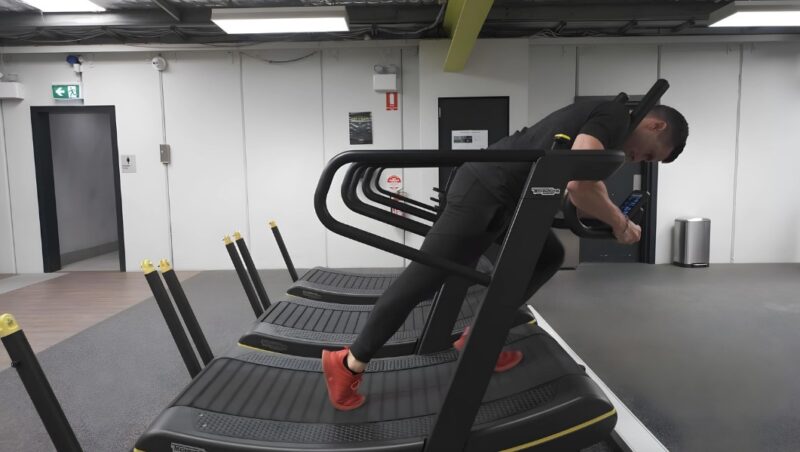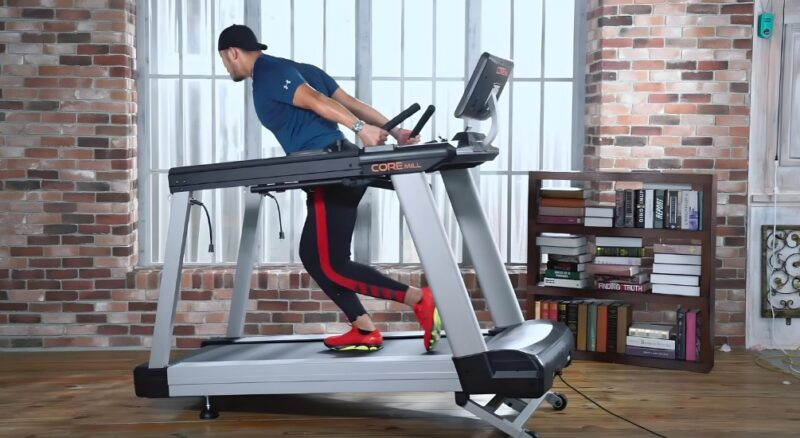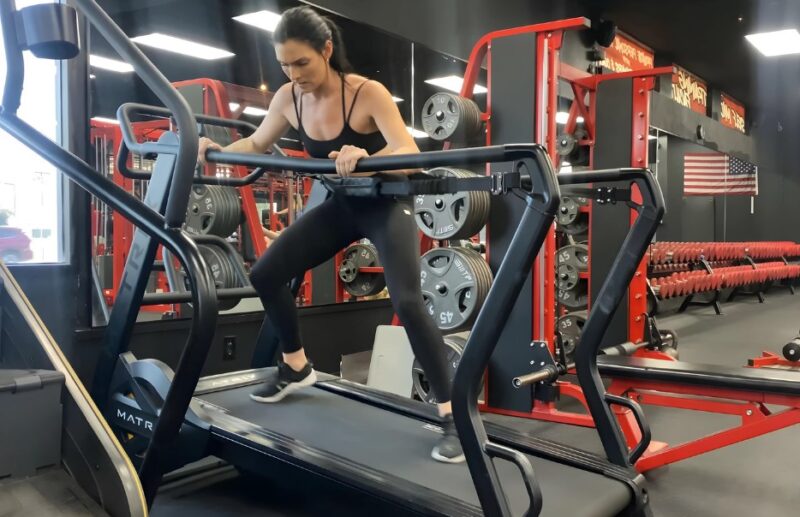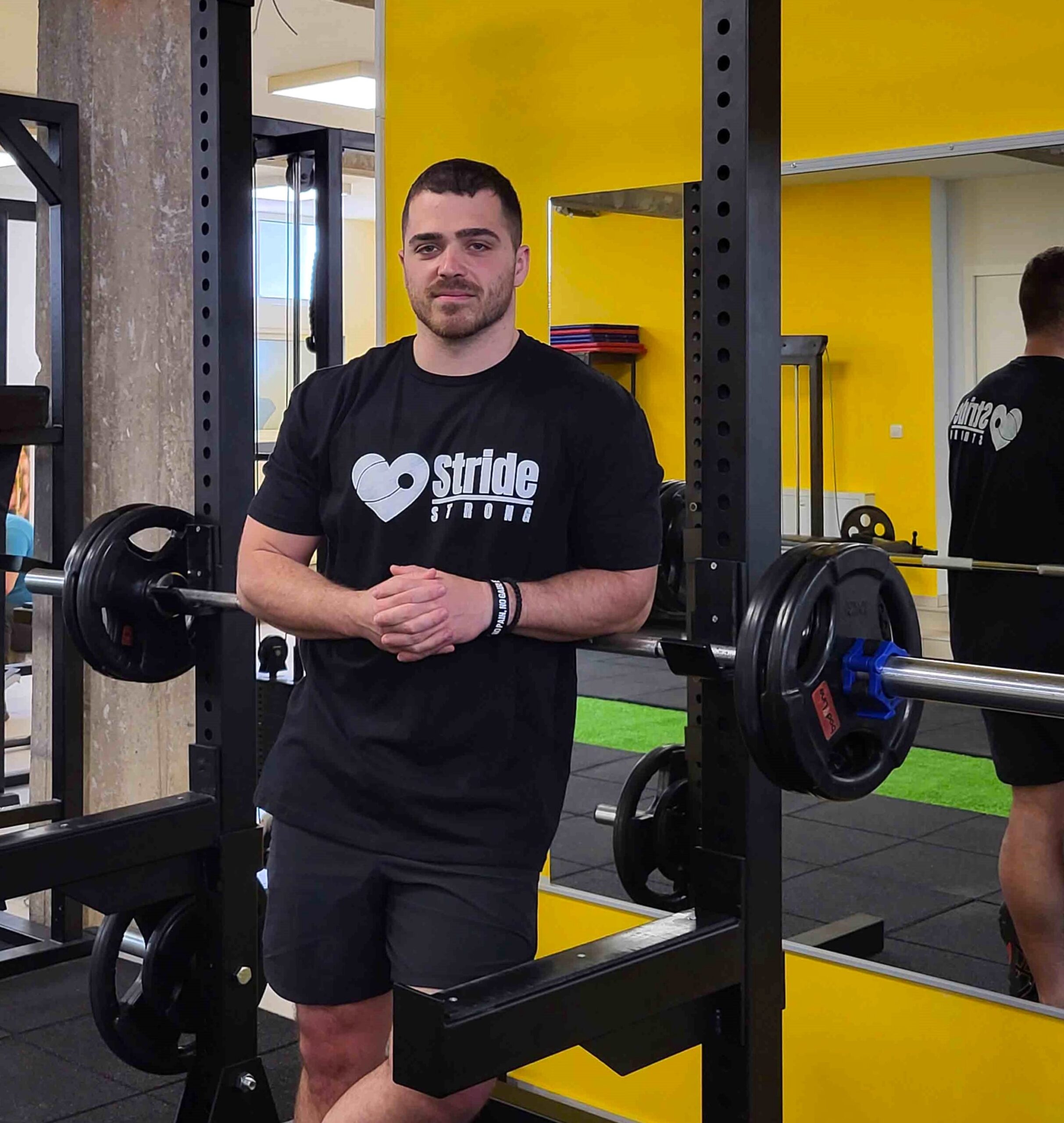Treadmills are usually the go-to machines for cardio workouts and weight loss, but what if I told you that they’re also fantastic for strength training? Yes, you read that right. The treadmill, a staple in gyms, isn’t just for running or walking.
It’s a versatile tool that can spice up your strength training routine, making your gym sessions more fun and effective.
I will guide you through five innovative ways to transform the treadmill from a cardio machine into a strength-training ally.
1. Tread Push
Imagine pushing a heavy sled across the gym floor. That’s what the tread push feels like, except you’re using the treadmill. Here’s how you do it:
- Stand behind the treadmill with your hands on the handlebars.
- With the treadmill off, drive the belt backward with your feet, mimicking a sled push.
- Focus on using your leg muscles and keeping your core tight.
This move targets your leg muscles and improves your core stability. It’s like giving your legs a challenging uphill battle to fight. It is something I struggled at first, but when you have a proper grip on it, it becomes seamless.
2. The Reverse Tread Push
This technique flips the tread push on its head. You’ll face away from the treadmill’s console and push the belt forward. It’s a bit tricky, but here’s a quick guide:
- Face the opposite direction on the treadmill (the treadmill is off).
- Push the belt away from you using your legs and feet.
- Keep a straight back and engage your core throughout the move.
The reverse tread push works your calves, hamstrings, and glutes from a different angle, enhancing your balance and core strength.
A thing I want to say is that I was a bit hesitant to conduct it because I didn’t see the benefits on the surface. But when after testing it out, it became clear to me that it is quite beneficial. After this acknowledgment, I do it whenever I have a strength training session.
3. Lateral Shuffle
Sidestepping on a treadmill is an interesting technique that might sound odd, but it’s an excellent way to work on your balance and core stabilization. Here’s how to do it safely:
- Set the treadmill to a slow speed.
- Stand sideways on the treadmill and begin to shuffle your feet, one in front of the other.
- Keep your core engaged and your body facing forward.
This lateral movement challenges your body in a new direction, promoting agility and core strength.
Lateral shuffle is probably the most interesting of them all since it provides you with a touch of versatility.
4. Mix It Up with Resistance Bands
Who knew a treadmill could be used with resistance bands? Attach a band to the stationary part of the treadmill and hold the other end.
You can perform:
- Squats
- Rows
- Presses
According to Michelle Lovitt, M.A. states:
“[Resistance bands] don’t take up any space, and you can work every single body part with a band when you’re on the treadmill.”
This combination targets every part of your body, making your workout more dynamic and effective.
5. Sprint Intervals Paired with Strength Exercises
Combining sprint intervals with strength exercises off the treadmill can create a comprehensive workout that burns fat and builds muscle. For example:
- Sprint for 30 seconds at a high intensity.
- Hop off and perform a set of bodyweight exercises, like push-ups or squats.
- Repeat the cycle for a full-body workout.
This approach keeps your heart rate up while engaging different muscle groups.
Sometimes, you can simply attach some dumbbells to your feet and start running a treadmill. The additional weight will work on your muscles, without a doubt.
Keeping Progression in Mind
While experimenting with these treadmill strength training methods, always prioritize safety and proper form. Start slow, focus on your technique, and gradually increase the intensity. Here are some tips:
- For tread pushes, ensure the treadmill is off and securely positioned.
- Begin lateral shuffles at a slow speed to maintain balance.
- Incorporate progressions, like increasing the treadmill’s incline, to challenge yourself further.
How Does Incline Work to Your Advantage?
Adjusting the treadmill’s incline is a simple yet effective way to increase the intensity of your workout without changing your speed. But how does it benefit strength training?
Walking or running at an incline targets different muscle groups in your legs, such as your glutes and hamstrings, more intensely than flat ground.
Additionally, it challenges your core muscles to keep you balanced and upright, providing a more strenuous workout.
Incorporating incline walks or runs into your routine can, therefore, enhance your strength training regimen by engaging a wider range of muscles.
The Role of Heart Rate in Strength Training
Monitoring your heart rate during treadmill workouts can provide insights into your fitness level and help you tailor your workout for optimal results.
For strength training, maintaining a heart rate between 60 and 85 percent of your maximum heart rate is generally effective for burning fat and building muscle.
This range encourages your body to utilize fat as an energy source while engaging and strengthening your muscles.
While we’re talking about cardiovascular health, a study by Iowa State University concludes that weight training helps by reducing the chance of experiencing a stroke or a heart attack between 40% and 70%.
Wearable fitness trackers or heart rate monitors on treadmills can help you stay within this target zone, ensuring your workouts are both safe and effective.
Safety First
Safety should always be your top priority, especially when experimenting with new exercises on the treadmill. Here are a few key safety tips:
- Always ensure the treadmill is at a complete stop before getting on or off.
- Use the safety clip if available. It ensures the treadmill stops if you happen to fall or step too far back.
- Start with the treadmill at a slow speed when trying new exercises, and gradually increase the pace as you become more comfortable.
- Pay attention to your footing and body positioning to prevent slips or falls.
Progressing Your Treadmill Strength Training
As you become more comfortable with these exercises, gradually increasing the challenge is vital for continued improvement. Here are a few suggestions:
- Increase the treadmill’s incline during tread pushes and walks to add resistance.
- Add more bodyweight exercises or increase the number of repetitions for each exercise.
- Incorporate intervals of higher-intensity sprints to elevate your heart rate and boost endurance.
To Sum It Up
| Progression Stage | Exercise | Description | Benefits |
| Beginner | Walking Lunges | Perform lunges on the treadmill at a slow speed to maintain balance and control. | Improves balance, strengthens legs and glutes. |
| Intermediate | Incline Power Walk | Increase the incline and walk briskly to engage more leg muscles and the core. | Enhances leg strength, boosts cardiovascular health. |
| Advanced | Incline Sprints | Perform sprints on a high incline setting to drastically increase intensity. | Maximizes cardiovascular endurance, burns fat. |
| Expert | Dynamic Side Shuffles | Increase the speed and perform side shuffles at an incline, alternating sides every 30 seconds. | Improves agility, enhances leg and core strength. |
| Master | High-Intensity Intervals with Bodyweight Exercises | Combine high-speed sprints with off-treadmill bodyweight exercises (e.g., burpees, push-ups). | Offers a full-body workout, improves muscle endurance. |
















